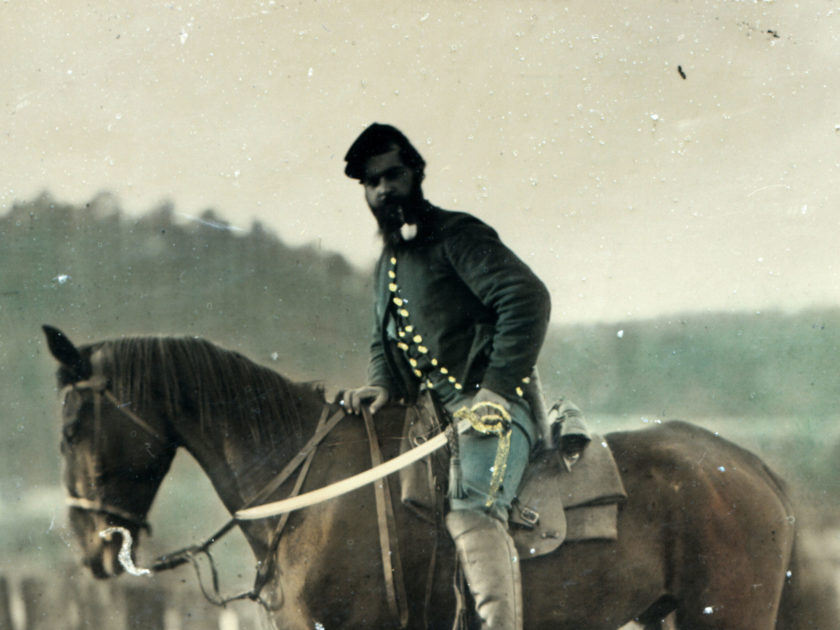Dan Schwab appreciates the connection that old photos make to long lost volunteers in blue and gray. “When I hold an image in my hand, I know that the soldier in the image unquestionably at one time held that very piece of tin or glass in his hand as well. He most likely took great care of it so that it could be sent home to his parents, siblings, wife or a sweetheart.”
A student of Civil War photography since his elementary school days, and a collector since the 1990s, Schwab searches for artfully composed photographs. “I especially like images that capture some of the character traits of the soldier or soldiers being photographed and leave you studying, searching and wishing for additional clues as to whom they may have been,” Schwab notes. “Every image has a story to tell, and I love those that leave it to our imagination to contemplate the additional details.”
The representative images from Schwab’s collection showcased here are more than stories yet to be told however, he observes. “Soldiers felt compelled to capture themselves in this moment of history and wanted it preserved for posterity. Now, over 150 years later, we are the caretakers of these treasured gifts.”
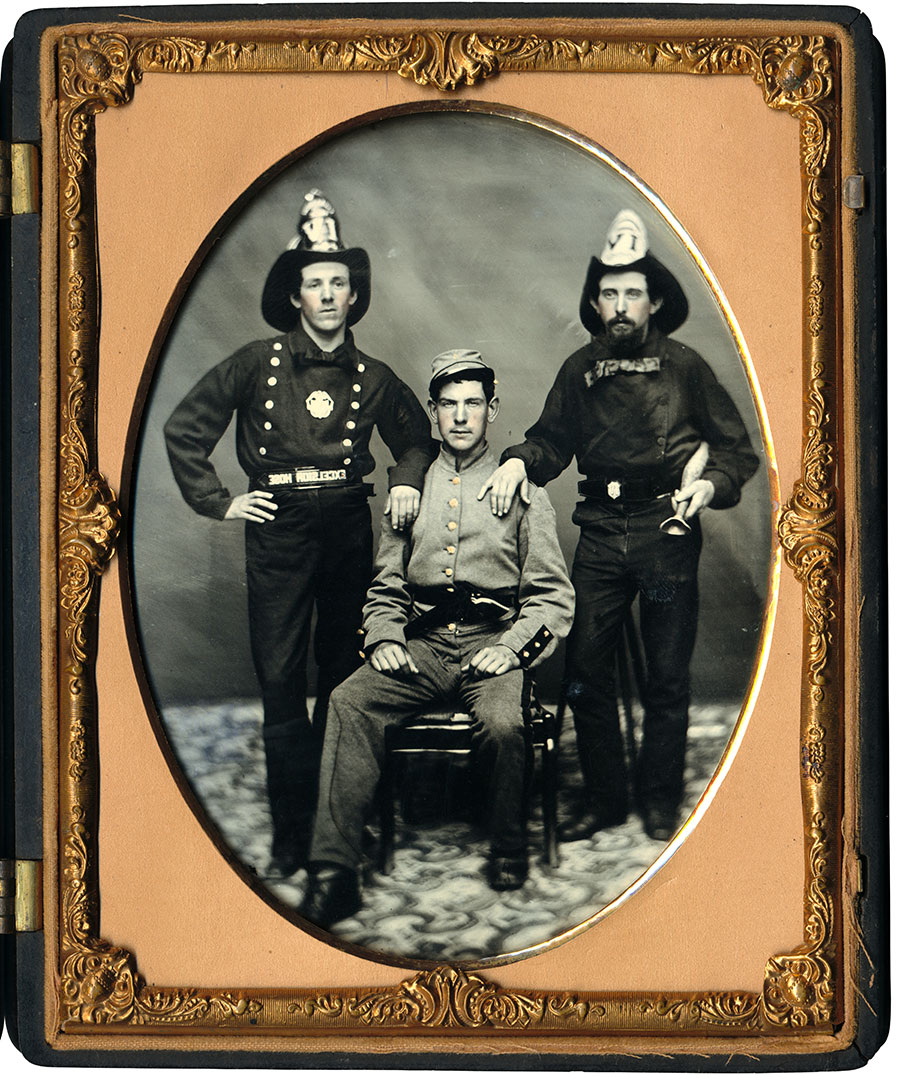
Two firemen rest supportive hands on the shoulders of a recruit in this early war portrait. The belt and helmets of the firemen indicate their membership in Excelsior Hose No. IV, and research strongly suggests that they were New Yorkers who belonged to the Buffalo Volunteer Fire Department. Excelsior Hose No. IV was an epicenter of patriotic fervor for local firefighters, and their station was a recruitment place for other Buffalo fireman. The man on the right holds a speaking trumpet tucked beneath his arm, and he is very likely the senior officer in command of the firehouse. The soldier, who sports a gray cap and matching shell jacket with dark cuffs, carries a sidearm tucked into a holster. He likely served in the “Fillmore Guards,” which became Company G of the 74th New York State Militia, or the 21st New York Infantry.

Six federal teamsters sit or kneel with bullwhips thrown over their shoulders or around their necks. The variety of hat and uniform styles suggests that they were detached from different regiments, a common scenario among teamsters.

From the relative comfort of Benton Barracks in St. Louis, a cavalry musician displays his weapons of war—a Remington revolver and a Cornopean, a less common brass instrument found in Civil War regimental and brigade bands.

A federal artilleryman wearing a cap with the visor upturned and a 12-button shell jacket with musician’s herringbone pattern across the chest holds a copper bugle commonly used by all branches of the military. In his other hand, he grasps a P-guard sword—possibly European in origin. His saber belt, rolled up on one leg instead of around his waist, is barely visible.
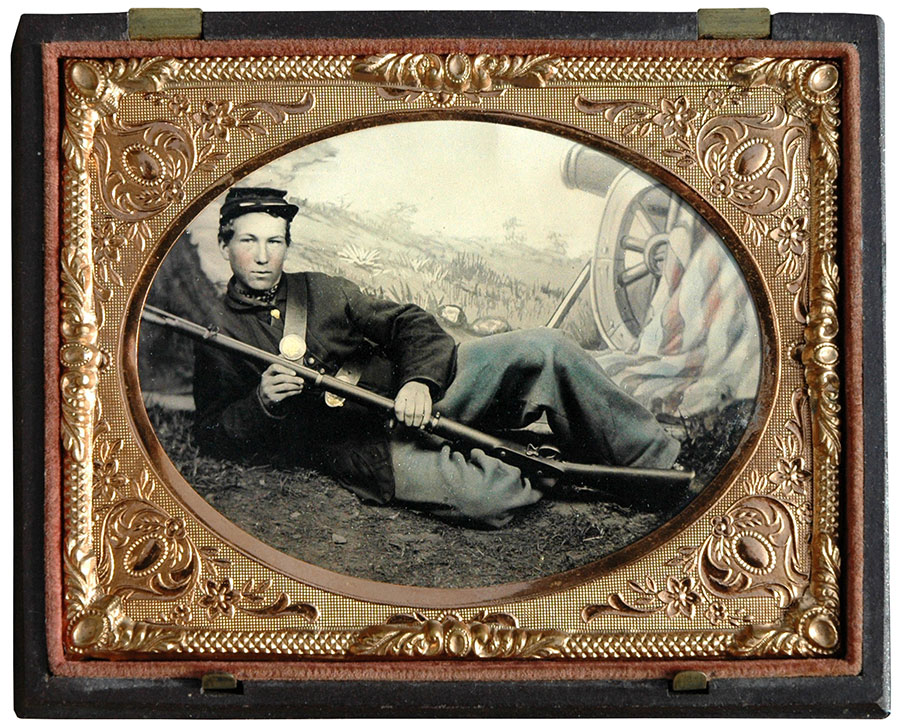
Dressed in a regulation Union private’s uniform, this soldier holds a Pattern 1853 Enfield rifle musket. The bare ground upon which he reclines blends nicely into the backdrop painted with a tree trunk, grassland and flag-draped cannon.
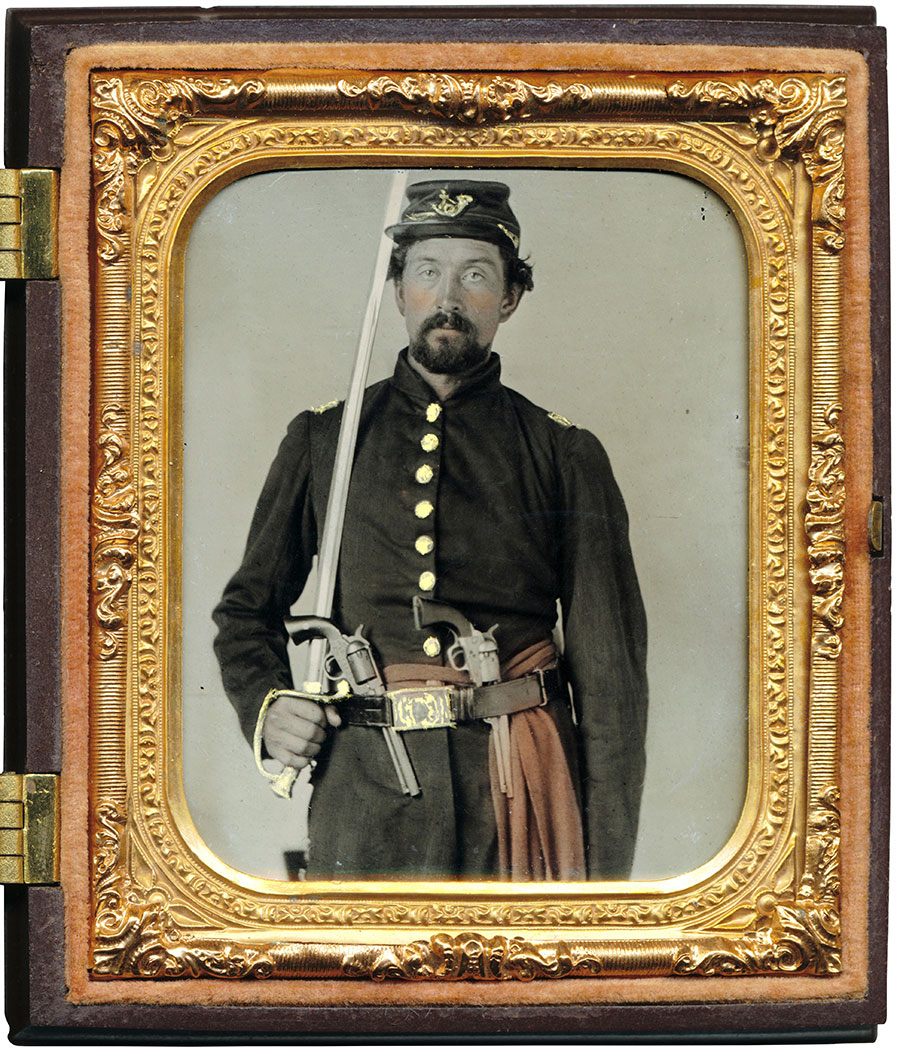
A Union officer carries a pair of revolvers, including a Model 1851 Navy Colt on the right, tucked between his waist belt and sash. He grasps a Model 1850 foot-officer’s sword with the blade pressed against his chest. The insignia on his cap is notable: Rather than standard brass, the infantry horn is made of embroidered cloth common to some militia organizations.

A pipe-smoking Union cavalry trooper sits gallantly upon his trusty mount, with one hand on the single rein bridle and the other grasping his Model 1860 saber. The horse is equipped with a McClellan saddle, minus saddlebags. The rest of the saddlery consists of a Dragoon curb bit and running martingale which helps set the head of the horse.

A Signal Corps second lieutenant peers through a telescope from the safety of a makeshift photographer’s tent. He is surrounded by some of the equipment used in the field, including two signal flags—one with a red square on a white field used in dark conditions, and another with a white square on a black field for light conditions. Suspended on the wall behind the officer is a copper canteen capable of carrying a half-gallon of turpentine or other combustible substance for lighting torches to send night signals. By its side lies a haversack in which wicks, matches, shears for trimming the torch and a funnel for filling the torch and flame shades were carried. Hanging on the far right is a canvas signal case for transporting staffs, flags and torches. The officer holds what appears to be a sheaf of notepaper with indecipherable writing upon it.
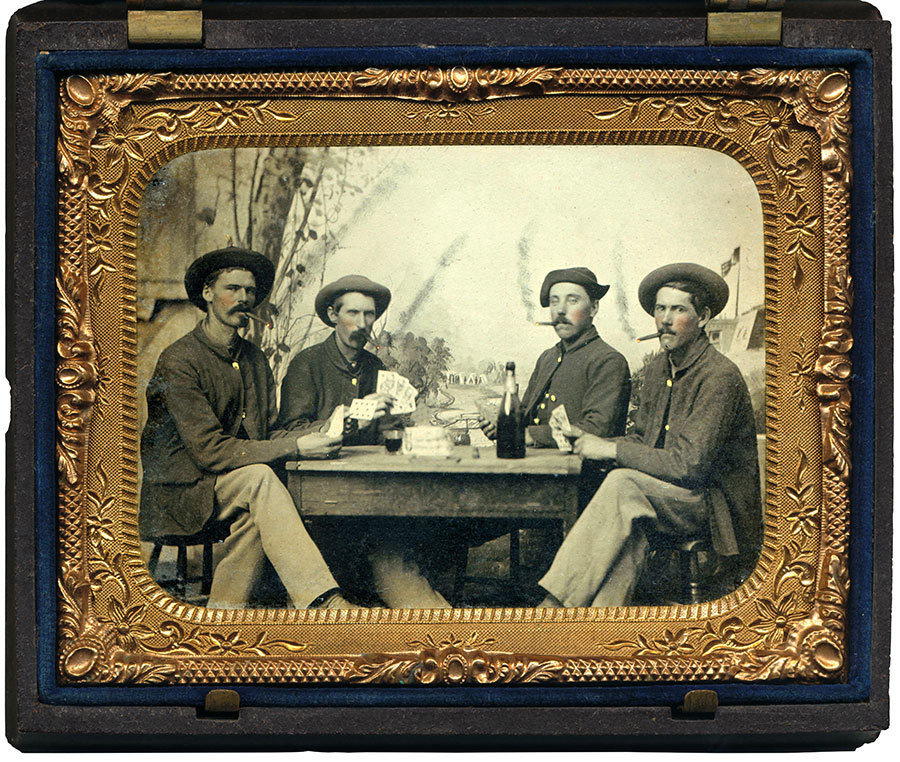
The best hand in this poker game likely belongs to the soldier seated second from the left—his three queens appear to trump his comrades. He also happens to be the only man drinking from the open bottle with the cork lying on the table next to it. No one seems to have touched the block of cheese or bread in the center of the table. But all four men savor cigars, to which the photographer or a colorist has added realistic glowing tips and wafting smoke. Dressed in standard four-button sack coats and non-regulation slouch hats, the privates pose before a backdrop that appears in other photographs attributed to Ansel R. Butts of St. Louis, Mo.

A pair of images visualizes the grim fate of a soldier. Youthful and full of life in a circa 1855 portrait, a boy with a hint of a mischievous expression rests his arm on a chair. The same boy grew up, joined the military and gave his life for his country. In this post-mortem image, he lies inside a canvas-walled tent on a cot dressed in a pattern 1851 enlisted man’s uniform. His sunken eyes, wan expression and his bony hands suggest he had died of disease or succumbed to a battlefield wound after a prolonged fight for his life. The drum placed in front of the cot indicates he may have been a musician. The Stars and Stripes leaves no doubt about his loyalty to the Union.
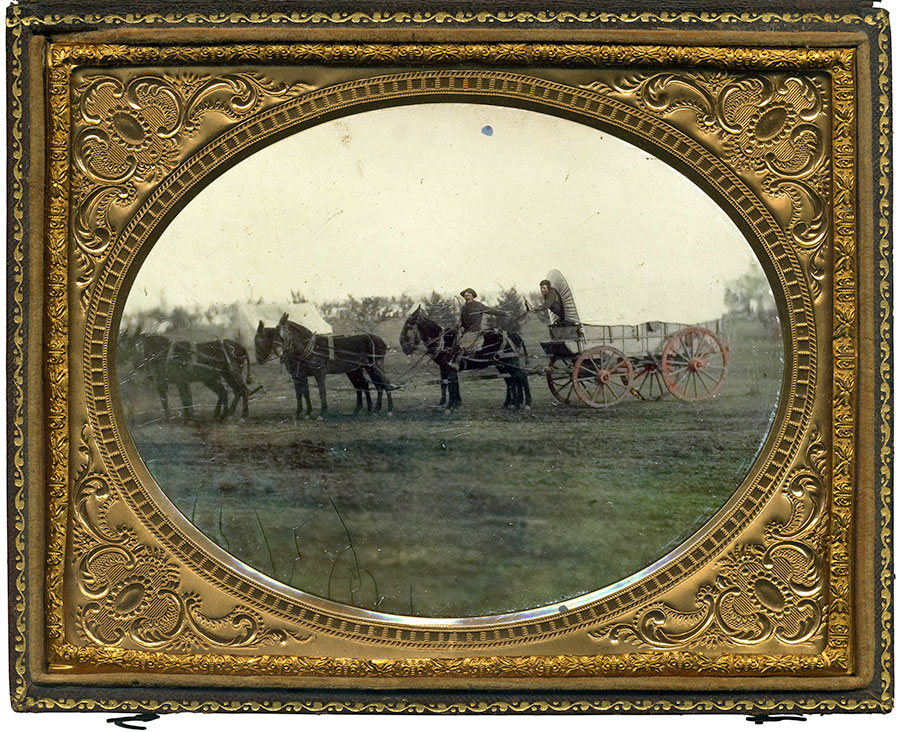
Take a swig! A Union officer leans out of the canvas top of a U.S. army wagon with a bottle of whiskey in hand, while a second soldier, mounted on one of the mules in the team, reaches back for the bottle. An accompanying note places the scene at Manassas, Va., in 1861.
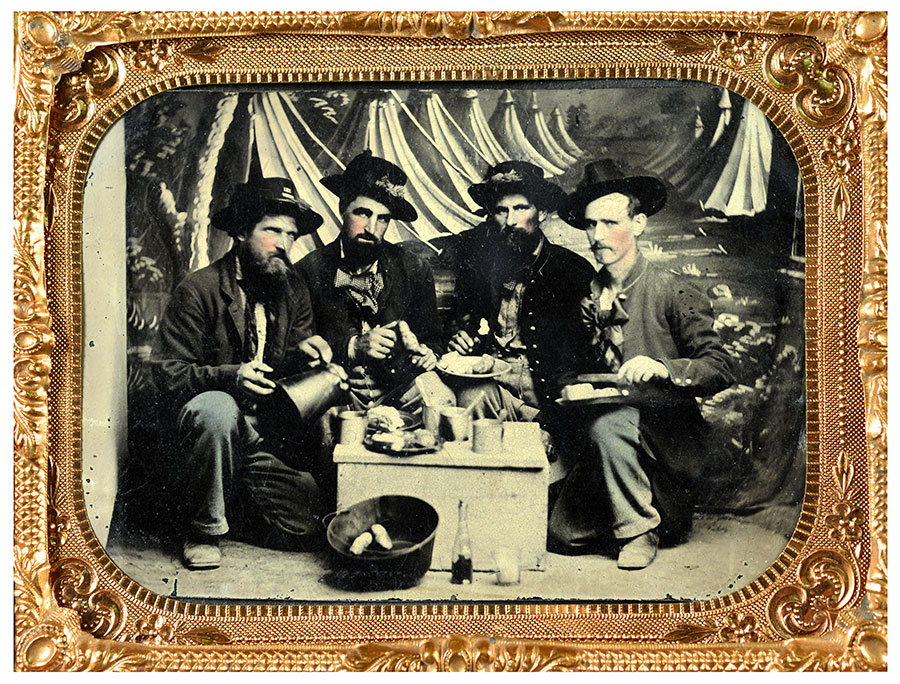
A large wood box serves as a dinner table for these four federals, enjoying a supper of meat, potatoes, bread and coffee—standard Civil War fare. An array of visible implements include plates, cups, flatware, bottles, a coffee pot and iron kettle. The hat worn by the soldier on the far left is marked with what appears to be the regimental number 131 or 133. Only five Northern states produced a 133rd infantry: Illinois, Indiana, New York, Ohio and Pennsylvania.
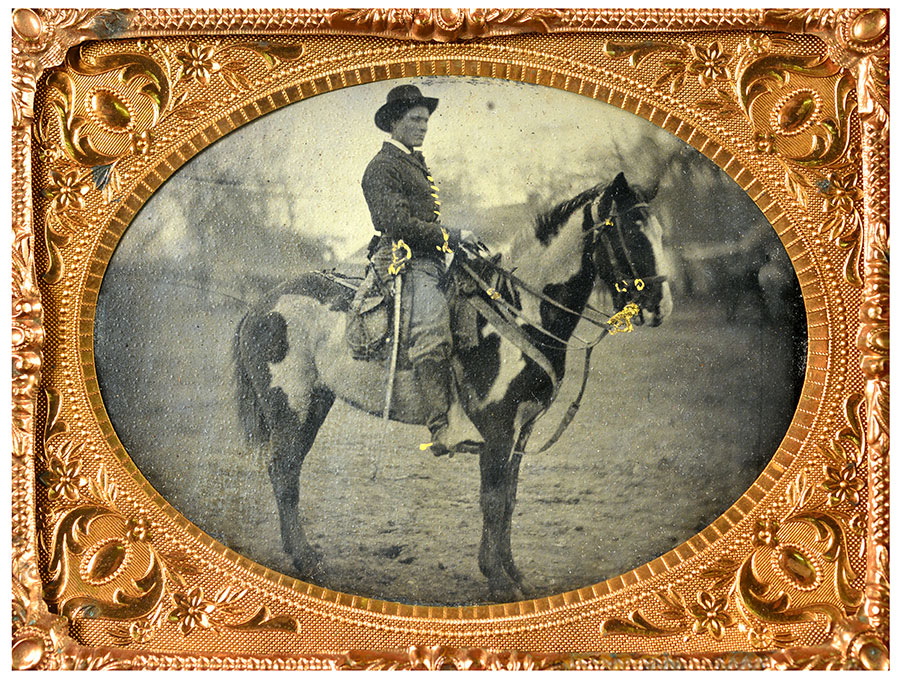
A piebald horse decked out in fine saddlery perhaps indicates that the federal trooper spared no expense to equip his mount. The gear includes a Model 1859 McClellan saddle with matching saddlebags. Also visible is a running martingale, a Y-shaped strap attached that connects the reins to the bit, which is used to control the movement of the horse’s head. The horseman wears a slouch hat and a short cavalry jacket, with a saber at his side.
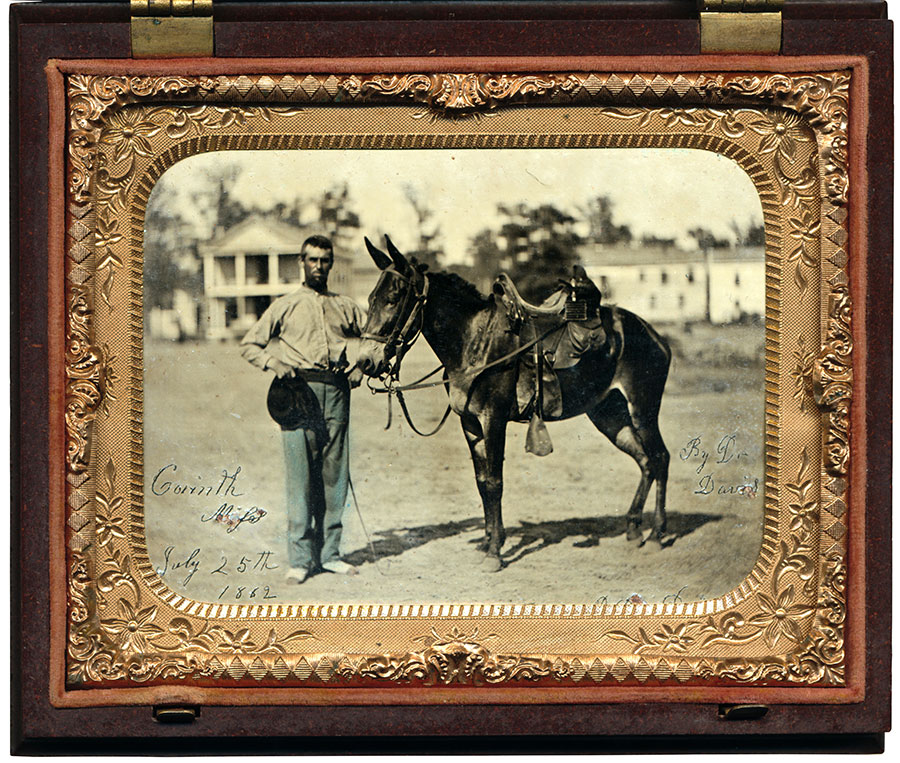
On July 25, 1862, two months after Confederates withdrew from Corinth, Miss., this federal posed for his portrait with a sure-footed mule at his side. The date and location are engraved into the plate. Also etched on the image is the name of the photographer, L. Davis. The name is repeated on the lower right of the plate, but is obscured by the brass mat. The photographer may have added his name to the latter location first, but later discovered that it was covered by the mat and wrote it again in a more visible spot. The soldier, dressed in shirtsleeves, wears what appears to be a pair of casual camp shoes. The mule is decked out in a McClellan saddle to which is fastened a comb.
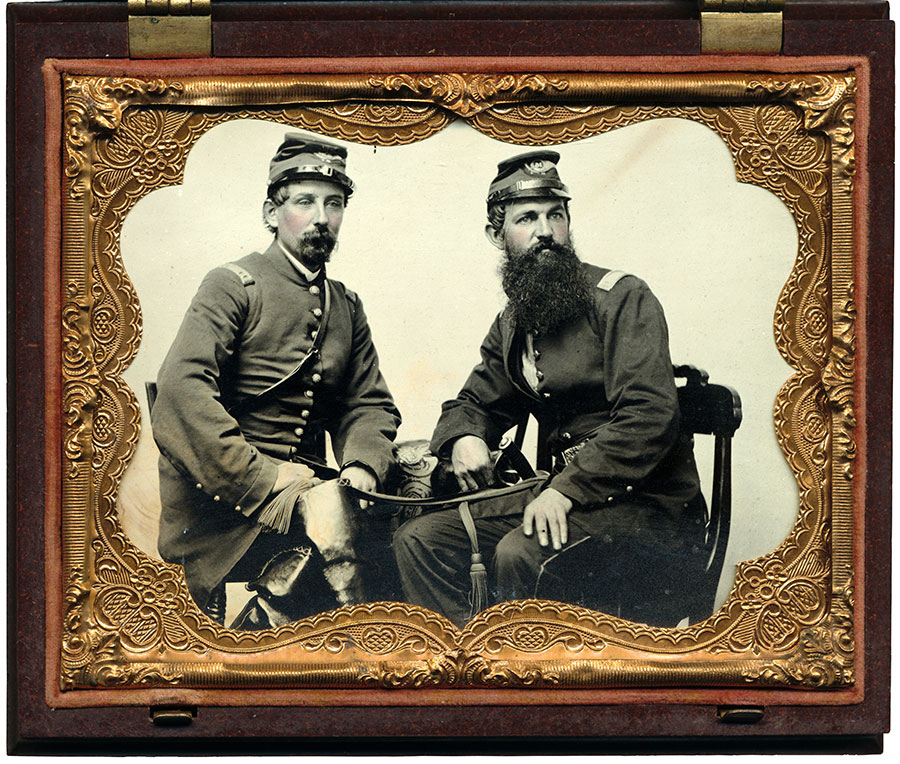
A sash draped across the laps of two infantry captains is perhaps symbolic of their bonds as comrades and friends. Their McDowell pattern caps and nine-button frock coats suggest the men sat for this portrait early in the war. The officer on the left wears knee-high boots with decorative stitching along the top edge. The sword carried by the other officer appears to be a Model 1860 cavalry saber. He also wears a pattern 1851 waist belt plate featuring an embossed eagle, and upon his cap the number 16 is visible.
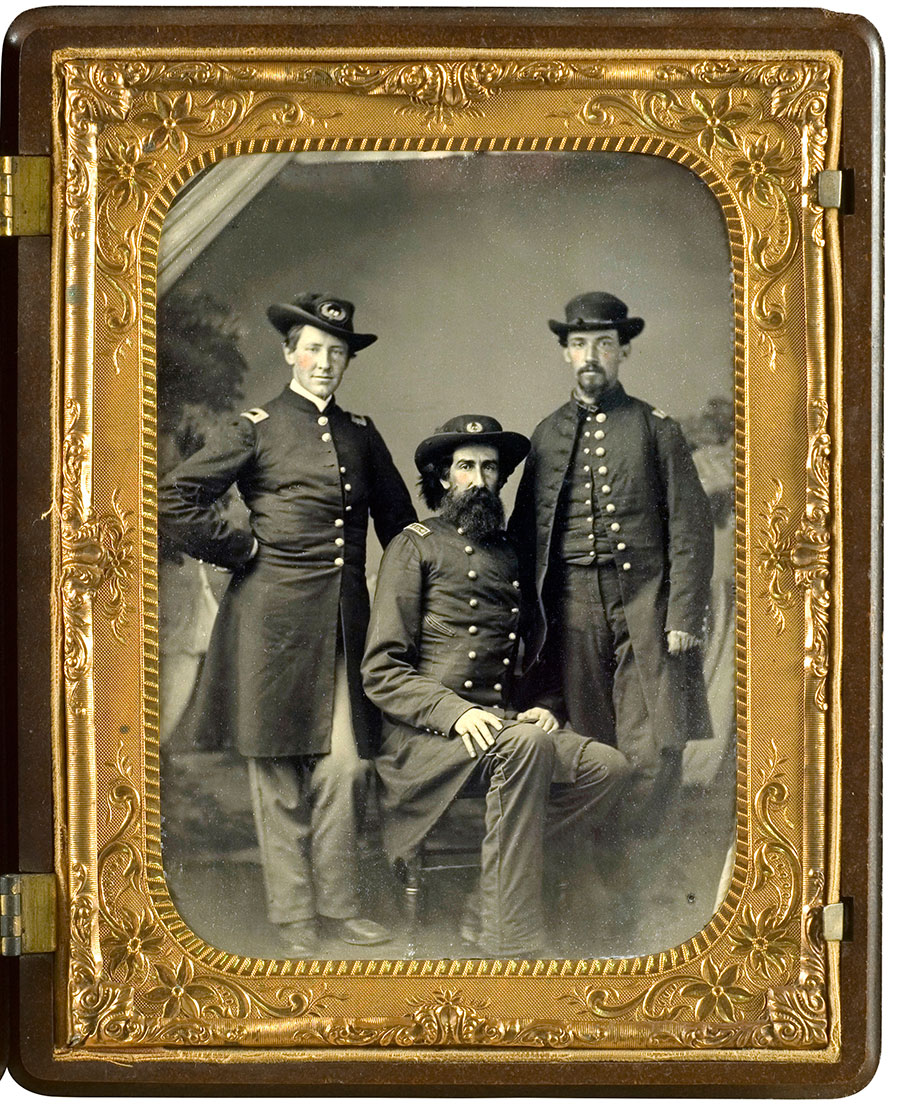
This image of a trio of federals has inscribed on the back, “Taken at Chattanooga Friday, December 18, 1863 on return from Knoxville march. A.E.” The officer in the center, who wears a hat with plume, is a surgeon as evidenced by his shoulder straps marked with “M.S.,” or Medical Staff, and a major’s insignia. The officer on the left, who also wears the Medical Staff insignia, is likely an assistant surgeon. The officer on the right may have been detached on special duty to assist the surgeons.
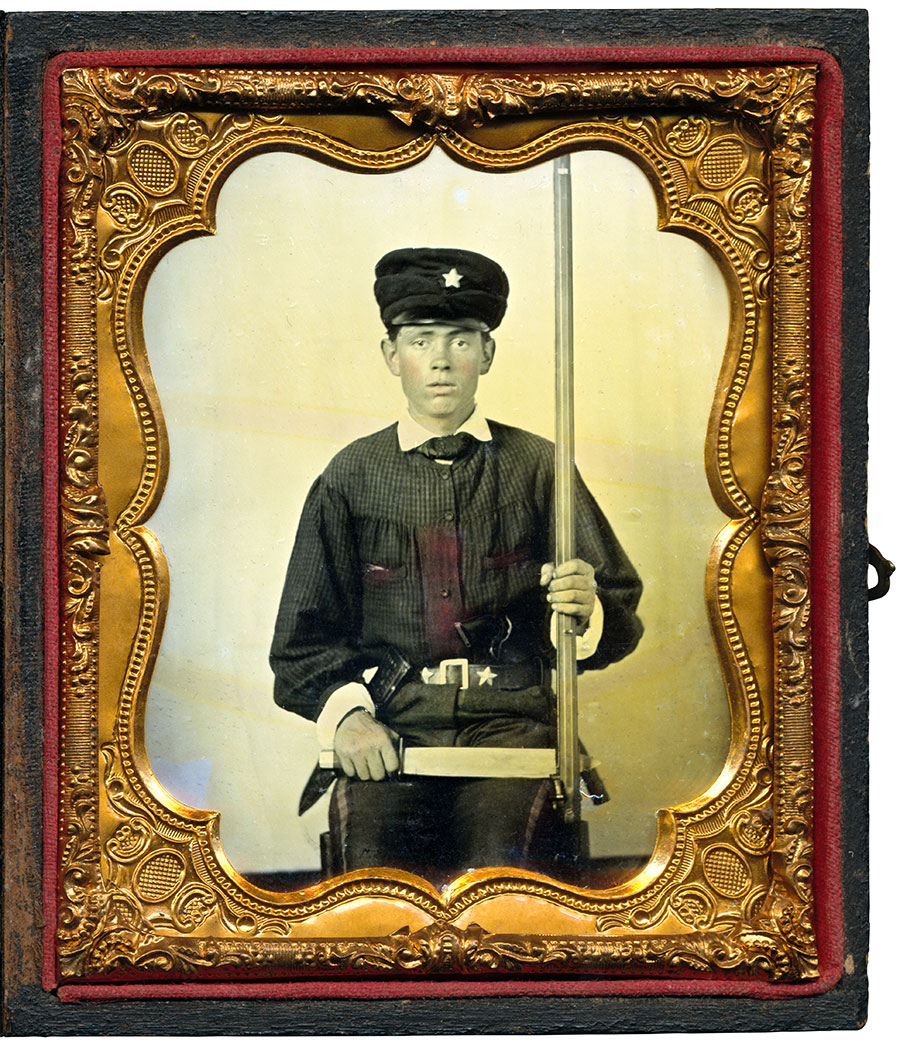
The five-point stars visible on the cap and waist belt buckle worn by this man are common to Confederates from Texas or Mississippi. He is armed with a clip point knife with brass cross-guard, holstered Colt Army or Navy revolver and a rifle. His cap, which appears to have earflaps fastened up and around the band, is likely a civilian work-style cap being used for military purposes.
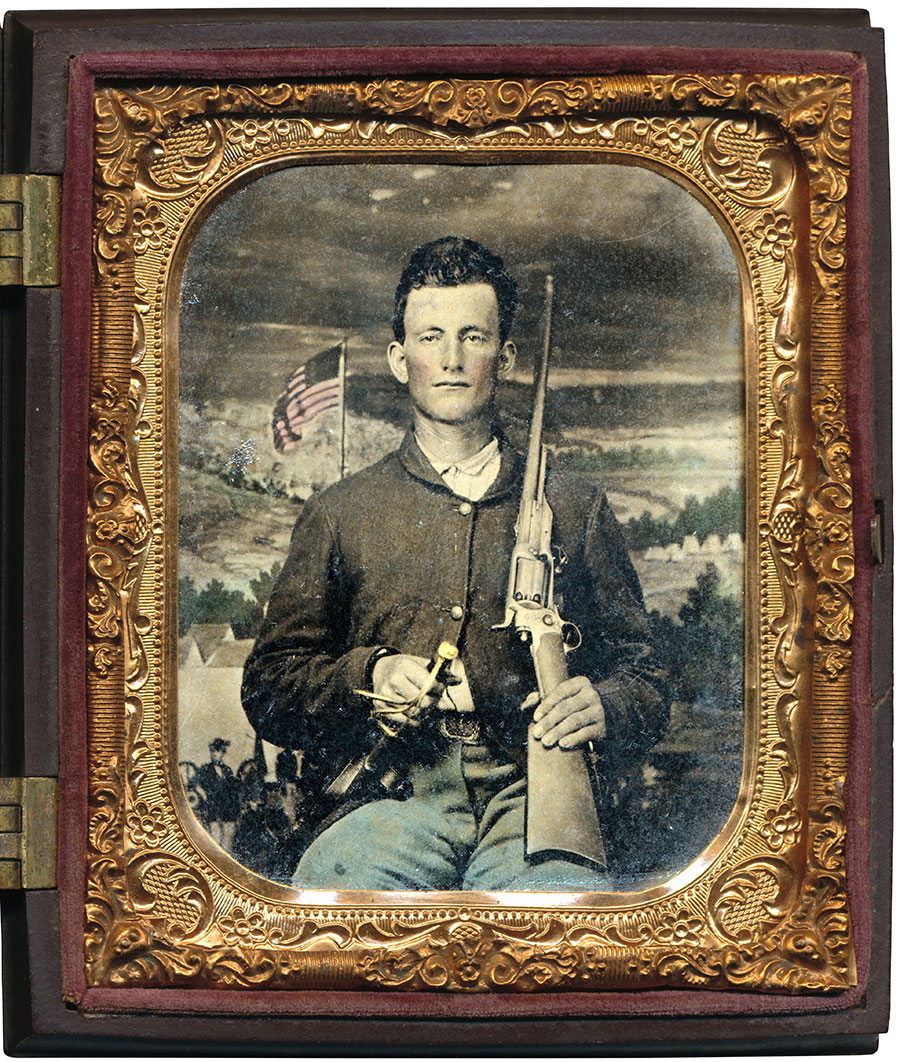
A steely-eyed soldier displays a Model 1855 Colt Revolving Carbine, and grips a Model 1860 Light Cavalry saber. Clad in a simple four-button sack coat secured with a pattern 1851 eagle waist belt plate, he sits before an ornate backdrop that features a camp, with the Stars and Stripes floating above the setting. The rapid-fire, .56 caliber gun, essentially a revolver attached to a rifled barrel and stock, suffered from safety issues. It was used effectively however, during the Civil War.

A group of Union officers relax before a tent and bough-covered fence, while an arbor protects them from the climate. The presence of a guidon and sabers suggests that these men were in the cavalry. The young African American in the front was probably a servant to one of the officers.
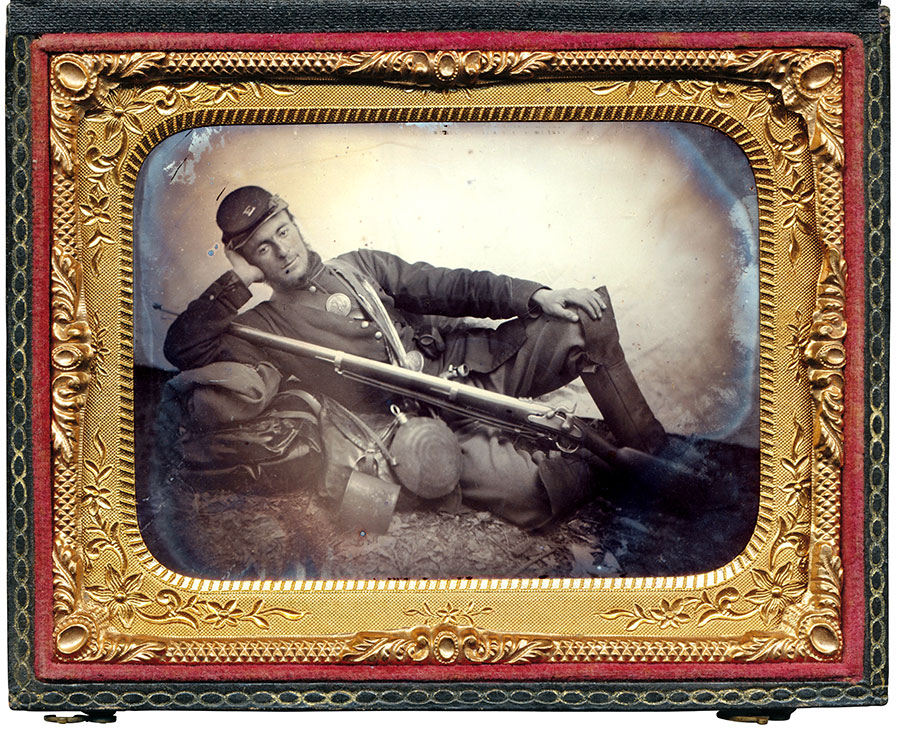
An early war Union infantryman poses with his standard-issue gear on the leaf-strewn ground of a makeshift photographer’s studio. The arm supporting his head rests on his knapsack, with his other hand on the knee-flap of his privately purchased boots. Visible equipment includes his Model 1861 Springfield rifle musket, oilcloth haversack, oblate spheroid “bulls-eye” style canteen and supersized tin mug. The only clue to the soldier’s identity is the larger brass E on his cap, which he flipped backwards to compensate for the reversed image process of the period.
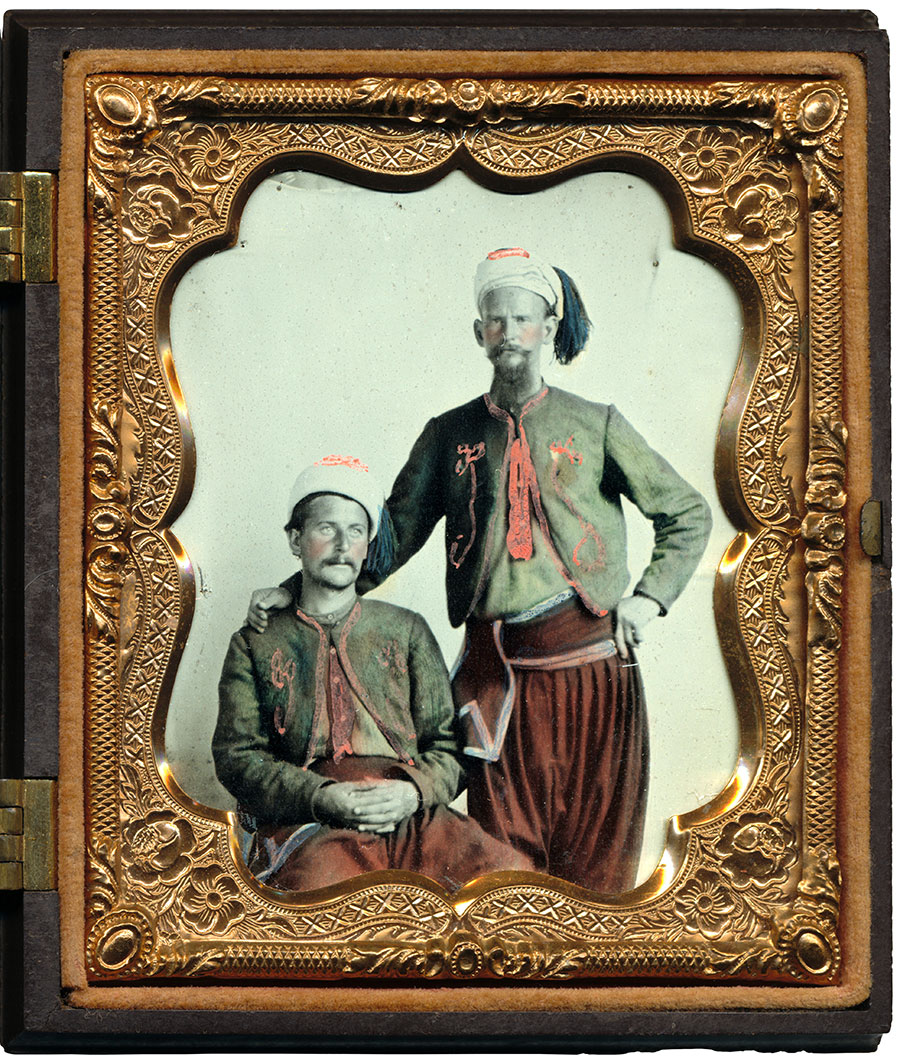
Two Zouaves strike a confident pose in their distinctive red trousers and sashes, red-trimmed jackets and blue-tasseled fezzes. The coloring and style of their uniforms indicates that they served early in the war with the 5th New York Infantry, better known as Duryee’s Zouaves, or later with the 165th New York Infantry, also known as the Second Battalion Duryee’s Zouaves and Smith’s Zouaves. John Hay, secretary to President Abraham Lincoln, described the men of the former regiment as “a jolly, gay set of blackguards,” who, “were in a pretty complete state of don’t care a damn.”
SPREAD THE WORD: We encourage you to share this story on social media and elsewhere to educate and raise awareness. If you wish to use any image on this page for another purpose, please request permission.
LEARN MORE about Military Images, America’s only magazine dedicated to showcasing, interpreting and preserving Civil War portrait photography.
VISIT OUR STORE to subscribe, renew a subscription, and more.

